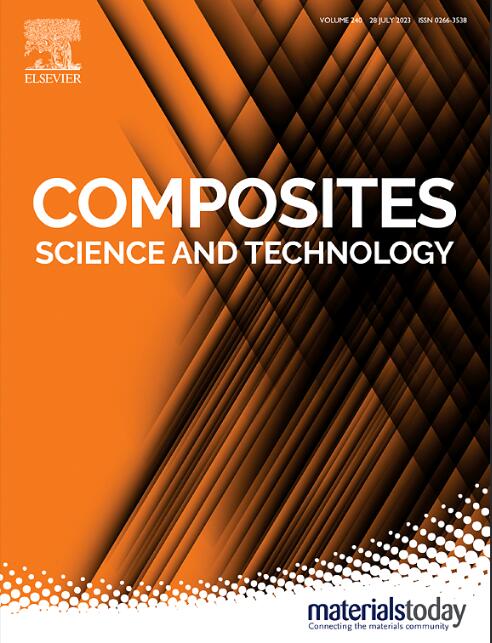Achieving Modulus Matching and Enhanced Fatigue Resistance in Chloroprene Rubber/Trans-1, 4-poly(isoprene-co-butadiene) Nanocomposites: A Study on the Balance Between Crosslinking and Crystallinity in Dispersed Domains
IF 8.3
1区 材料科学
Q1 MATERIALS SCIENCE, COMPOSITES
引用次数: 0
Abstract
Improving the fatigue resistance and service life of chloroprene rubber (CR) nanocomposites through cost-effective rubber blending technology is a highly desirable goal for both academic research and industrial applications. However, critical challenges remain, particularly in optimizing the structure of the secondary component within CR matrix, which significantly affects mechanical durability. In this study, the incorporation of trans-1,4-poly(isoprene-co-butadiene) (TBIR) as a secondary component with CR was explored to produce CR/TBIR (90/10) vulcanizates with different TBIR domain structures, achieved by varying sulfur content. The results demonstrated that increasing sulfur content significantly enhanced crosslinking density in TBIR domains with a high proportion of disulfidic and polysulfidic bonds, and reduced TBIR crystallinity. Additionally, filler dispersion was significantly improved. At an optimal sulfur content (1.0 phr), the CR/TBIR-1.0 vulcanizate achieved an optimized TBIR domain structure with balanced crosslinking and crystallinity, leading to improved modulus matching between CR and TBIR domains. This resulted in superior mechanical properties, including enhanced tensile strength, elongation at break, abrasion resistance, and greatly improved tensile fatigue life, with damping properties remaining almost unchanged compared to CR vulcanizate. The optimized TBIR domains exhibited synergistic effects from adequate crosslinking density, moderate crystallinity, and improved filler dispersion through the whole matrix, facilitating modulus matching for superior stress transfer, inhibited crack initiation and enhanced fatigue resistance. Compared with conventional CR-based rubber blends, this study provides a novel structural optimization strategy, demonstrating that precisely tuning crosslinking density and crystallinity of TBIR domains offers a promising route to develop durable, high-performance elastomeric damping nanocomposites.

在氯丁橡胶/反式-1, 4-聚(异戊二烯-共丁二烯)纳米复合材料中实现模量匹配和增强抗疲劳性:关于分散域中交联与结晶度之间平衡的研究
通过经济高效的橡胶共混技术提高氯丁橡胶(CR)纳米复合材料的抗疲劳性能和使用寿命,是学术研究和工业应用的高度期望的目标。然而,关键的挑战仍然存在,特别是在优化CR矩阵中二次组件的结构方面,这将显著影响机械耐久性。本研究探讨了反式-1,4-聚(异戊二烯-共丁二烯)(tir)作为副组分与CR的掺入,通过不同的硫含量制备出具有不同tir结构的CR/ tir(90/10)硫化橡胶。结果表明,随着硫含量的增加,tir结构域的交联密度显著增加,双硫键和多硫键的比例较高,tir结晶度降低。此外,填料的分散性也得到了显著改善。在最佳硫含量(1.0 phr)下,CR/TBIR-1.0硫化胶实现了优化的tir结构,交联和结晶度平衡,从而改善了CR和tir结构域之间的模量匹配。这导致了优异的机械性能,包括增强的抗拉强度、断裂伸长率、耐磨性和大大提高的抗拉疲劳寿命,与CR硫化橡胶相比,阻尼性能几乎保持不变。优化后的tir结构域具有良好的交联密度、适度的结晶度和填料在整个基体中的分散性等协同效应,有利于模量匹配,从而实现良好的应力传递,抑制裂纹萌生,增强抗疲劳能力。与传统的cr基橡胶共混物相比,该研究提供了一种新的结构优化策略,表明精确调整tir域的交联密度和结晶度为开发耐用、高性能的弹性阻尼纳米复合材料提供了一条有前途的途径。
本文章由计算机程序翻译,如有差异,请以英文原文为准。
求助全文
约1分钟内获得全文
求助全文
来源期刊

Composites Science and Technology
工程技术-材料科学:复合
CiteScore
16.20
自引率
9.90%
发文量
611
审稿时长
33 days
期刊介绍:
Composites Science and Technology publishes refereed original articles on the fundamental and applied science of engineering composites. The focus of this journal is on polymeric matrix composites with reinforcements/fillers ranging from nano- to macro-scale. CSTE encourages manuscripts reporting unique, innovative contributions to the physics, chemistry, materials science and applied mechanics aspects of advanced composites.
Besides traditional fiber reinforced composites, novel composites with significant potential for engineering applications are encouraged.
 求助内容:
求助内容: 应助结果提醒方式:
应助结果提醒方式:


